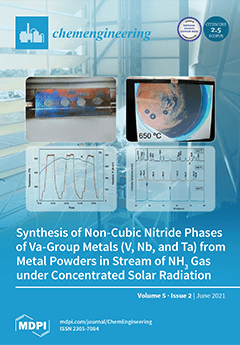A new analytic approach is presented for determining the total volatile fatty acids (VFA
T) concentration in anaerobic digesters. The approach relies on external determination of the inorganic carbon concentration (C
T) in the analyzed solution, along with two strong-acid titration
[...] Read more.
A new analytic approach is presented for determining the total volatile fatty acids (VFA
T) concentration in anaerobic digesters. The approach relies on external determination of the inorganic carbon concentration (C
T) in the analyzed solution, along with two strong-acid titration points. The C
T concentration can be determined by either a direct analysis (e.g., by using a TOC device) or by estimating it from the recorded partial pressure of CO
2(g) in the biogas (often a routine analysis in anaerobic digesters). The titration is carried out to pH 5.25 and then to pH 4.25. The two titration results are plugged into an alkalinity-mass-based equation and then the two terms are subtracted from each other to yield an equation in which VFA
T is the sole unknown (since C
T is known and the effect of the total orthophosphate and ammonia concentrations is shown to be small at this pH range). The development of the algorithm and its verification on four anaerobic reactor liquors is presented, on both the raw water and on acetic acid-spiked samples. The results show the method to be both accurate (up to 2.5% of the expected value for VFA
T/Alkalinity >0.2) and repetitive when the total orthophosphate and ammonia concentrations are known, and fairly accurate (±5% for VFA
T >5 mM) when these are completely neglected. PHREEQC-assisted computation of C
T from the knowledge of the partial pressure of CO
2(g) in the biogas (and pH, EC and temperature in the liquor) resulted in a very good estimation of the C
T value (±3%), indicating that this technique is adequate for the purpose of determining VFA
T for alarming operators in case of process deterioration and imminent failure.
Full article





